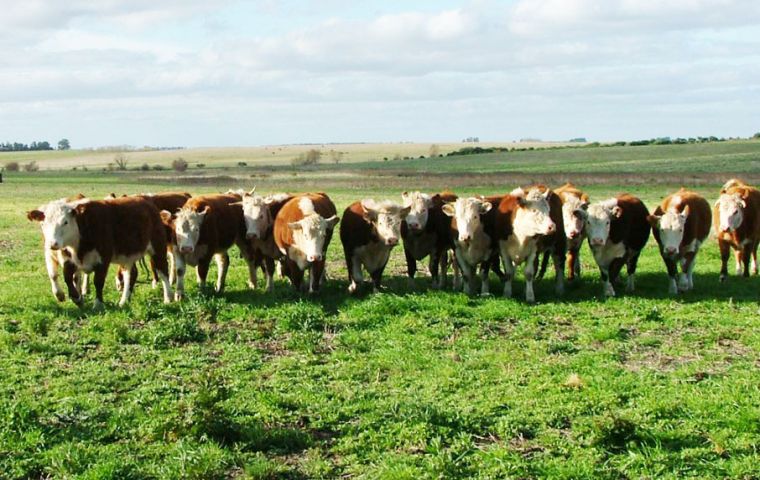MercoPress. South Atlantic News Agency
Uruguay's meat exports in four months total 550m with beef the main item, 454m
 To 18 April, 674,656 cattle were slaughtered in approved slaughterhouses across Uruguay, an increase of 9% compared to the previous year.
To 18 April, 674,656 cattle were slaughtered in approved slaughterhouses across Uruguay, an increase of 9% compared to the previous year. Uruguay exported meat, offal, meat products and by-products worth 550 million dollars in the year up to 18 April, 8% more than the same period of 2014. Beef exports totaled 454 million in the first months of the year, with the main buyers including China, member countries of the North American Free Trade Agreement (NAFTA), the European Union, Israel and MERCOSUR countries.
The total volume of beef was 115,731 tons exported, whereas in 2014 the number stood at 102,154 tons. The change in revenue and the change in volume of beef exports therefore both amount to increases of 13%, compared with the same period in 2014.
For Uruguayan sheep meat, exports totaled 21 million dollars and about 4,642 tons. The main buyers were similar to the main buyers of beef.
The income from beef represent 82% of the total export revenue, while the share of sheep meat is only four per cent, according to data published by the Directorate of Information and Economic Analysis of the National Meat Institute (INAC).
In addition to these two main exports, there were exports of meat offal worth 30 million, horsemeat for 8 million and 2.3 million in poultry meat. Another 34 million was raised from exports of industrialized product, edible residual byproduct, primary byproducts of industrial and meat product feed.
As for the volume of animals slaughtered, 674,656 cattle were slaughtered in approved slaughterhouses across Uruguay by 18 April, which is an increase of 9% compared to the previous year.
In related news a US Department of Agriculture report forecast India will strengthen its position as the world's biggest beef exporter with volumes up 13%. Meanwhile, Australia, the US and Brazil will export less this year, strengthening India's role as the number one beef exporter.
The USDA predicted an overall global marginal fall in beef production, to just over 59 million tons.
“Overall, the forecasts suggest that the world beef industry is continuing in its realignment, with India increasing its importance, while the US and Australia assume a declining role.
“It would seem that Russia is likely to become a less important destination for beef exports in the medium term while Asian markets such as China and Hong Kong continue to increase in popularity amongst global exporters.




Top Comments
Disclaimer & comment rules-

-

-

Read all commentsBut what about methods? It's hard to find information. It's all very well for Uruguayan cattle to be grass-fed, but what about the rest of the meat production process. I no longer purchase New Zealand meat products ever since I found out that everything at New Zealand slaughterhouses has to have some arabic gibberish muttered over it and is then left to bleed out. There's no stunning. Some people might ask what it matters. After all, we only eat meat once it's dead. Does it matter how it gets that way? I think it does. If you're driving along and see a dead sheep at the side of the road, obviously the result of roadkill, do you stop, pick it up, throw it in your vehicle and decide to have a barbecue? Do you eat horse? Cats? Dogs? Rats? How about other humans? Humans are omnivores. We can eat many things. It's all meat, isn't it? Some have principles. I like to eat various types of meat. But not if the animal had to be made to suffer unnecessarily in the process.
May 02nd, 2015 - 11:02 am 0There is very little difference between the slaughter for kosher and for halal purposes. Research suggests that kosher slaughter in Uruguay is unnecessarily cruel.
As matters stand, I would no more purchase Uruguayan meat than I would New Zealand meat.
Fortunately, I see little sign of Uruguayan meat in my part of the UK. But Uruguay needs to research its customer base!
Bugger me , I thought NAFTA was petrol in Castellano
May 02nd, 2015 - 02:24 pm 0When you enlarge the picture of the argy government,
May 02nd, 2015 - 07:04 pm 0one immediately notices the similarity with a bunch of cows,
, just mooing like.....moo
Commenting for this story is now closed.
If you have a Facebook account, become a fan and comment on our Facebook Page!